In a 2010 study published in the journal Developmental Science, Karin Harman James researched the relation between handwriting and visual processing of letters, and found that the “specialized processing [in the brain] that occurs during letter perception may be the result of our sensori-motor experience with letters. Physical interaction with the environment through sensor-motor interactions informs visual processing, and could potentially be crucial for normal object recognition to develop”.
These findings have important implications for children when learning and practicing numbers. Through the physical action of handwriting the brain processes information differently, which enables the development of cognitive skills that keystroke methods cannot replicate. The sensorimotor experience in engaging with numerals through gestures - the act of writing - needs to be considered when implementing technology within the math curriculum.
The Digital Solution
Through using digital ink, software developers are utilizing the advantages of technology for learning, whilst maintaining the crucial benefits of a paper-and-ink education. Handwriting recognition engines allow users to write-by-hand that the software will recognize.
“It’s important to consider all of the cognitive processes involved in solving mathematical problems”, says Jane Abrams, an educational researcher from one such company. “As creators of educational apps, we’ve included the digital ink technology so rather than restricting users with ‘ready-made’ numbers, we provided appropriate maths practice for all stages of development.”
If a student’s ability to quickly access cognitive information relating to numerals is impaired, it could have flow-on effects on their ability to learn and master more complex mathematical challenges. As educators of the next generation, educating with these new generational tools, let’s ensure we incorporate holistic, innovate technology into our classrooms.


















